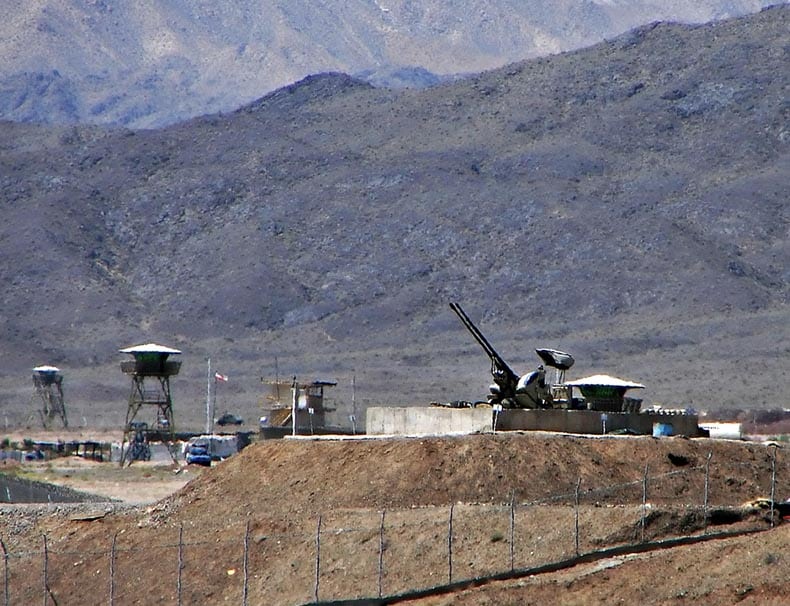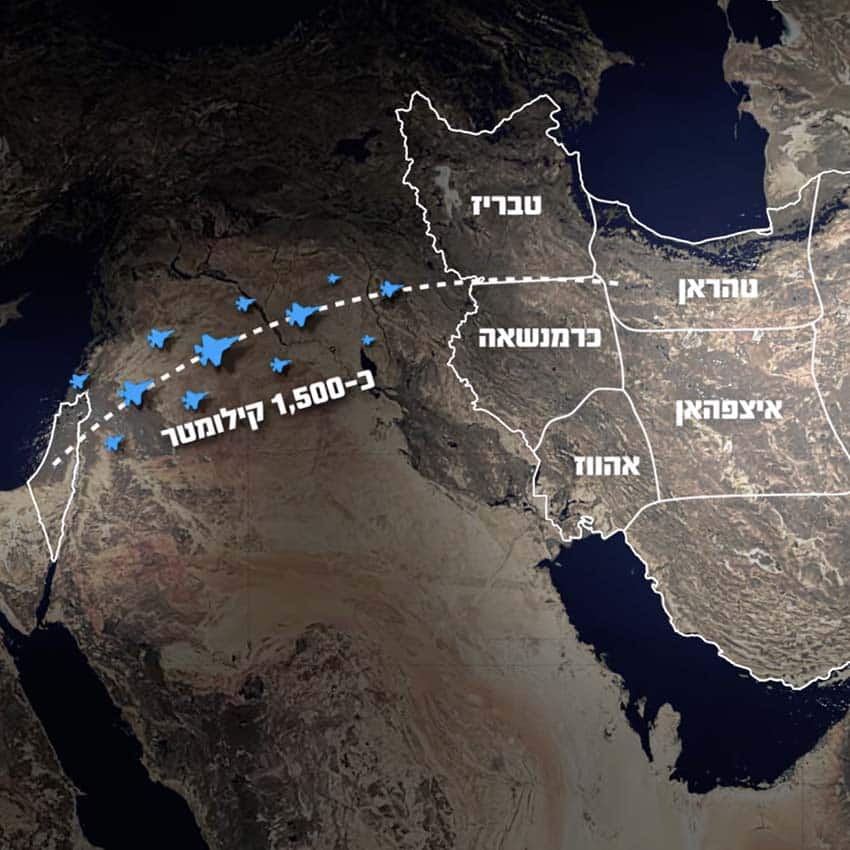On the night of Friday, June 13, 2025, the world was introduced to a new Middle East. Iran awoke to a reality of strategic chaos after Israel executed a secret and sophisticated strike dubbed “The Rising Lion.” The operation, which may turn out to be the most significant event in the state’s history and one of the most critical moments in Jewish history, at least partially lifted the threat of nuclear annihilation that had loomed over Israeli citizens, symbolically close to the 80th anniversary of the liberation of the concentration camps.
During the initial strike, Israel eliminated key figures in Iran’s defense and nuclear establishment, including Chief of Staff Mohammad Bagheri, Revolutionary Guards Commander Hossein Salami, and atomic scientists Dr. Fereydoon Abbasi-Davani and Dr. Mohammad Mehdi Tehranchi. Israeli Air Force jets destroyed critical infrastructure such as air defense systems, strategic facilities around Tehran, and the Natanz nuclear site, while paralyzing early-warning systems. Beyond the physical destruction, the operation shattered the Iranian regime’s self-confidence and exposed its weaknesses to the world. The success relied on years of covert infiltration, complete intelligence dominance, and brilliant psychological warfare, turning Iran into a victim of its false assumptions. The operation not only disrupted Tehran’s ability to respond but also positioned Israel as a dominant player in the Middle East, sending a clear message: the Jewish people will no longer live under existential threat.
The Media as an Unwitting Agent
In the months leading up to the operation, the Israeli media, unwittingly, became a central tool in the deception plan. Senior journalists, believing they were uncovering behind-the-scenes realities, fell victim to a sophisticated disinformation campaign. For example, Haaretz’s political analyst Haim Levinson claimed that Benjamin Netanyahu was a coward who wouldn’t dare open a front against Iran. Barak Seri, a commentator for Channel 12 News who had previously failed in his bid for the mayorship of Ashdod (after unsuccessfully seeking the support of Likud and the ultra-Orthodox parties), asserted that Netanyahu’s relationship with Trump was in deep crisis. He claimed that the American president was preventing an attack out of fear of regional escalation, failing to realize that leaks about such a rift were part of a smokescreen intended to lull Iran into complacency. Ronen Bergman, a journalist for Yedioth Ahronoth and The New York Times, reported that the IDF Chief of Staff and the Air Force commander were firmly opposed to a strike. He did not foresee that the IDF was fully participating in the deception and was placing operational assets inside Iran, ready for immediate action.
These three journalists, along with many others, did not recognize that they were serving as conduits for spreading false information. The Israeli media, which prides itself on its freedom of expression, became an unwitting agent of Netanyahu and Trump. Their hollow analyses fed Iran’s complacency, leading Tehran to believe that Israel was distracted, weak, or restrained by Washington.
This case highlights the dangers of making bold media declarations without a solid foundation. The journalists, thinking they were exposing secrets, were advancing Israel’s plan. They failed to realize they were part of a much larger game in which controlled leaks and false narratives were intended to shape the enemy’s perceptions. Their inability to read the map turned them into valuable tools in the deception, demonstrating just how detached the media can be from reality when relying on assumptions instead of facts. The Israeli media, seeing itself as the gatekeeper of a supposedly threatened democracy under Netanyahu, unintentionally became a cog in Netanyahu’s deception machine and fueled Iran’s mistaken perception that Israel would not act.

Collapse of Iran: A Chain of Miscalculations
Iran fell victim to a series of strategic mistakes based on false assumptions about Israel, the United States, and regional dynamics. The Iranian regime interpreted American criticism of Israeli actions in Gaza as a sign of distancing between Washington and Jerusalem. It is believed that the Trump administration, having returned to nuclear talks, would prevent an Israeli strike out of fear of escalation that could destabilize the Middle East. In reality, coordination between the U.S. and Israel was tighter than ever, and the diplomatic talks served as a cover for military action. Tehran failed to grasp that Washington and Jerusalem were working together to create an illusion of diplomacy while preparing for decisive military action.
Tehran also underestimated Israeli intelligence capabilities, assuming—after the October 7 attack—that Israel’s intelligence services were no longer what they used to be. It could not fathom that Israel was capable of carrying out a complex operation inside Iranian territory, despite two prior events that should have served as warning signs. In July 2024, Israel eliminated Hamas leader Ismail Haniyeh in the heart of Tehran, bypassing multiple security layers and demonstrating extraordinary penetration capability. In September, in a sophisticated attack on Hezbollah in Lebanon—in which operatives used explosive communication devices—dozens were killed and thousands wounded, showcasing Israel’s ability to disrupt enemy networks. Shortly thereafter, Hassan Nasrallah was also assassinated in an underground bunker in Lebanon. Yet Iran dismissed these signals, seeing them as isolated incidents rather than parts of a coordinated campaign.
The regime also miscalculated timing. When Trump issued a 60-day ultimatum on April 12 to stop uranium enrichment, Tehran perceived it as a political maneuver rather than a binding deadline. It continued enriching uranium, believing it had maneuvering space. Israel, however, acted precisely on the 61st day, taking Iran by complete surprise. The regime’s complacency was also bolstered by support from China, which had deepened ties with Tehran following their 2021 strategic cooperation agreement valued at $400 billion. Iran believed that China would provide geopolitical protection, but Beijing remained on the sidelines and did not intervene in response to Israeli actions.
The collapse of the Assad regime in Syria, triggered by Israeli strikes and internal defections, left Iran without a key anchor in its proxy network. For over a decade, Damascus had served as a logistical hub for transferring weapons to Hezbollah and militias in Iraq. Still, Tehran failed to conclude from Assad’s fall and did not adapt its deterrence strategy to the new reality. It continued to believe that it could control the region through its network of allies, failing to realize that Israel had already dismantled this structure. Iran’s normalization with Saudi Arabia, brokered by China in 2023, was perceived as a breakthrough that would neutralize Riyadh’s opposition to its nuclear program; however, this was also an illusion. The agreement created an optical shift, not a strategic one, leaving Iran exposed.
These erroneous assumptions—regarding Israel’s weakness, China’s support, and sustained regional control—created a window of opportunity that Israel skillfully exploited. The operation was not merely a military strike but a coordinated symphony of deception and psychological warfare. Israel shaped a false informational environment that lulled Tehran into deadly complacency. Secret cabinet meetings approving the operation were disguised as routine discussions about hostage negotiations. Senior ministers signed stringent confidentiality agreements, and the Israeli public—along with Iranian intelligence—remained unaware of the operational plans.
Controlled leaks to the media, suggesting that Prime Minister Netanyahu would not take dramatic action before his son Avner’s wedding on June 15, reinforced the impression that he was distracted by personal matters. Reports of Mossad chief trips to Washington, supposedly for nuclear program negotiations, strengthened the sense that a diplomatic solution was near. Rumors of a rift between Netanyahu and Trump, spread in the media, convinced Iran that Israel would not act without American approval.

Psychological Warfare: The Mind Behind the Blow
At the heart of Operation “The Rising Lion” was psychological warfare against Iran. This was not merely a supporting tool but a central weapon that ensured the operation’s success. This type of warfare is the art of shaping the enemy’s perception to disrupt its decision-making processes, weaken its morale, and prevent an adequate response. Israel used it to lull Iran into a state of complacency, exploiting the centralized nature of Tehran’s regime, where every decision depends on the upper echelons. By injecting false information into Tehran’s informational environment, Israel ensured that the regime would not activate emergency protocols, would not disperse its senior officials, and would not raise its alert level. The result was that Iran’s warning systems detected nothing because the attack originated from within. Precision drones and explosives, pre-positioned inside Iran, were activated with surgical precision while the regime still believed it was safe.
The Israeli operation demonstrated that psychological warfare requires a profound understanding of the enemy, from its culture and decision-making processes to its foundational assumptions. Iran, as a centralized and ideological regime, was particularly vulnerable to such deception. Israel exploited Tehran’s belief that threats would come from the outside and be accompanied by open escalation, such as troop buildups or diplomatic warnings. By operating from within Iran, Israel turned the regime’s sense of security into a double-edged sword. The psychological effect of the attack—the feeling that the enemy was inside their home—was more devastating than the physical damage. It created doubt and confusion among the senior ranks, who feared internal betrayal as much as external penetration, and this fear paralyzed the regime, leaving it unable to coordinate a response or even grasp the scale of the attack.
Several layers characterized the psychological warfare employed in the operation against Iran. The first, as noted, was the creation of a false informational environment. Controlled leaks to Israeli and international media painted a picture of a weak, divided Israel restrained by the U.S. Reports of internal crises and mounting domestic criticism of Netanyahu, or a rift with Trump, convinced Iran that an attack was unlikely. The second layer was disrupting the enemy’s decision-making processes. By cutting off communication and command systems, Israel ensured that Iranian officials could not coordinate a timely response. The third was inducing cognitive paralysis. The attack, originating from within Iran, left the regime uncertain: was this an external penetration or internal betrayal?
The drones and explosives used in the operation had been hidden for years, exploiting weaknesses in Iranian supply chains and infrastructure. Cyber operations disrupted the regime’s communication systems, leaving it blind and deaf during the assault. The result was that Tehran, beyond failing to anticipate the attack, also did not understand its objectives until it was too late.
American support for the operation was critical but remained behind the scenes. The Trump administration adopted a clear model: full support for allies like Israel, using them as a lever of pressure against U.S. rivals. In a tweet designed to mask the close coordination, Trump called Netanyahu “crazy” and suggested Iran quickly reach an agreement, hinting that he did not control Israel. In practice, the U.S. provided ammunition, diplomatic cover, and international backing, but refrained from active participation at this stage. This model allowed Washington to keep its hands clean while granting Israel a green light to act as the operational arm of Western interests.

Penetration and Elimination: The Blow That Came from Inside Iran
The operation was based on years of covert penetration into Iran’s infrastructure and systems. As noted, Israel managed to position precision drones, explosives, and attack systems within Iranian territory, bypassing air defense systems. These assets were carefully concealed and remained dormant until the moment of action, preventing any chance of early detection. The strikes hit critical targets: air defense systems were destroyed before they could respond, strategic facilities around Tehran suffered severe damage, and the Natanz nuclear facility—the heart of Iran’s nuclear program—took a blow that would delay it for years. The damage to infrastructure was significant, but the real target of the operation was people.
The elimination of the Chief of Staff, the commander of the Revolutionary Guards, the commander of the Quds Force, the Air Force commander, and many other senior officials who played central roles in planning and executing Iran’s strategy disrupted the Revolutionary Guards’ chain of command. The assassinations of nuclear scientists Dr. Davani and Dr. Tehranchi, who were the backbone of the nuclear program, created a vacuum that will be difficult to fill in Tehran’s rigid and centralized regime. Much like the assassination of Admiral Yamamoto in World War II, which crippled Japanese naval coordination, the Israeli operation struck at the heart of Iran’s strategic capability, leaving it paralyzed.
The Israeli penetration was not only physical but also cyber. Iranian communication systems were cut, and command and control networks were disabled even before the first strike. The result was chaos: Iranian officials were unable to communicate, coordinate, or understand the scope of the attack. The fear that seeped into the regime—that the attack came from within—amplified the paralysis. Iran did not know whether it had fallen victim to external infiltration or internal betrayal, and this uncertainty prevented any significant response from being made. The operation demonstrated that in modern warfare, the advantage belongs to those who control information and perception. Israel did not merely attack Iran—it shaped the reality in which the regime operated, turning its centralized structure into a fatal vulnerability.
From Without and Within: Iran on the Brink of Crisis
Iran tried to respond, but its reaction exposed its limitations. Supreme Leader Ali Khamenei promised a “bitter and painful” revenge and launched over a hundred drones and missiles at Israel on the first day of the campaign. The Iranian strike managed to turn off parts of Israel temporarily and resulted in casualties, but it was far weaker than expected from a regional power like Iran. Israeli air defenses, in cooperation with American systems, neutralized most of the threat, and the damage—while not diminishing the immense pain for every Israeli who lost their life—was limited compared to the scale of the Israeli offensive. Nevertheless, Israel must remain cautious: we are only at the beginning of Iran’s response, and complacency could be dangerous. The regime in Tehran is still capable of inflicting harm, and the Israeli operation, successful as it was, has not ended the conflict.
The Israeli penetration may expose deep cracks within the regime. Trust within the Revolutionary Guards and the intelligence establishment is naturally eroded when senior officers begin to suspect one another. The fear of internal betrayal leads to paranoia, threatening to unravel the system from within. Iran’s partners—Hezbollah, the Houthis, Hamas, and militias in Iraq—who themselves suffered devastating blows from Israel in the recent war, are beginning to doubt Tehran’s ability to lead the axis of resistance. If Iran cannot protect itself, how can it defend its allies? This gap erodes the regime’s regional deterrence and threatens its standing as a regional power.
Inside Iran, the crisis is even more profound. The gap between Khamenei’s promises and the reality on the ground undermines the regime’s legitimacy. The Iranian public, already suffering from a prolonged economic crisis and much of it resentful of the leadership, is beginning to doubt the regime’s ability to protect the country. In a regime where legitimacy depends on projecting strength, failure against Israel is a severe blow. These cracks could lead to long-term political disintegration, with risks of senior defections, uprisings in peripheral regions, and instability that may threaten the regime’s very existence.
Israel, by contrast, demonstrated complete control. It absorbed Iran’s response with limited damage, maintained national composure, and continued to dictate the pace of the conflict. The operation not only struck Iran but also sent a message to the world: Israel sets the rules in the Middle East. It proved that in an era of modern conflicts, the advantage belongs to those who know how to act covertly, swiftly, and decisively.
American support for the operation was critical, though it remained behind the scenes. The Trump administration adopted a clear model: full support for allies like Israel, using them as leverage against America’s adversaries. This support not only strengthened Israel but also sent a message to Iran and America’s other rivals: Washington’s allies will receive full backing, and the price for provoking them will be steep.
This operation offers critical lessons for the West, particularly for the United States, and several conclusions and insights for dealing with nuclear threats:
- Covert penetration is essential: Monitoring alone, such as that of the International Atomic Energy Agency, is insufficient against a regime that hides its intentions.
- Elimination of key figures: Scientists, engineers, and senior officers are the heart of a nuclear program, and targeting them paralyzes it.
- Strategic surprise: Quick, unexpected action prevents escalation and maintains the initiative.
- The effectiveness of force: Military action strengthens negotiations by changing facts on the ground.
- Israel as a defensive wall: The current operation proved that Israel is a key player in preventing nuclear proliferation.
- Diplomatic leverage: Battlefield successes strengthen negotiating positions.
- Intelligence and enforcement: Knowledge without action weakens deterrence.
What began on October 7, 2023, with a massacre in Israel and the feeling that the Jewish state was more vulnerable than ever against Iran’s sophisticated chess game, ended in a resounding victory. The operation proved that Israel is stronger than ever, while the Iranian regime has fallen into the greatest crisis in its history, perhaps on the verge of total collapse. Israel not only struck Iran but also exposed its weaknesses and plunged the oppressive ayatollah regime into an existential crisis. Thanks to the operation, at least a significant portion of the nuclear threat over Israel has been removed, and the Jewish people were likely spared from a nuclear holocaust that the Revolutionary Guards would have inflicted upon them.
Exactly eight decades after the Holocaust—the Jewish state delivers a preemptive blow to the Nazis. We are proving to the world that we need rely on no one else, as the verse from Deuteronomy, upon which the operation was named, declares: “Behold, the people shall rise as a lioness, and as a lion shall he lift himself; he shall not lie down until he eats of the prey, and drinks the blood of the slain.”






